Tropicfeel has been producing a wide range of travel gear over the past few years, often with a focus on multi-functionality — think travel shoes that can also be used in the water or backpacks that can be transformed depending on the trip.
Most recently they’ve launched the Tropicfeel Nest, a new daypack and everyday backpack that promises to be highly versatile as well. Having had the chance to test it for two weeks, this is my candid review. (As usual, there are no sponsored reviews on my blog.)
Pros
- Lightweight and well designed
- Clever side pocket access
- Works perfectly with smart packing cube
- 'Kangaroo' pocket adds extra packing volume
Cons
- Not suitable for long trips
Who is the Nest for?
The Nest is a continuation of the product line that started with the Tropicfeel Shell, which I reviewed before. It shares several key features with its backpack cousins.
Whereas the Shell is intended to be a main travel backpack, the Nest is more of a daily carry. Based on its size and features, it’s ideal for day-to-day use, trips to the beach, city travel, commuting, and other everyday scenarios.
However, the Nest can also be expanded in various ways, making it suitable for a weekend trip as long as you pack reasonably light.
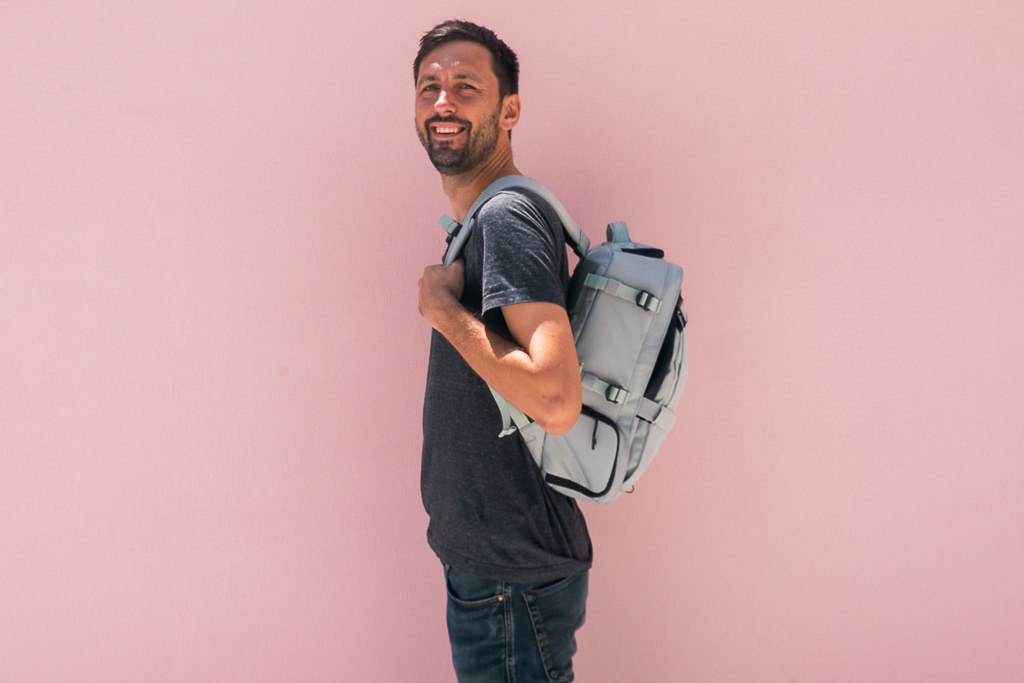
If you’re looking for a main travel backpack (for trips of a week or longer) then I don’t recommend the Nest, as it’s simply too small unless you’re an extreme minimalist. In this case, I would look at the Tropicfeel Shell or consider other larger travel backpacks.
But if you’re looking for a daily carry backpack or daypack, then the Tropicfeel Nest is a very capable one.
When combined with a camera cube, the Nest can also be an excellent camera bag for photographers or content creators, with its quick-access side zipper being an especially compelling feature.
The Nest’s most clever feature
Let’s cut straight to the chase: what’s the best aspect of the Nest?
If you ask me, it’s the protected side pocket.
This clever pocket lets you easily store something at the bottom of the pack while accessing it easily from the side.
There are many scenarios in which this can be an extremely handy feature. My first thought was to use it as a camera pouch. However, it would also store things like food, or anything else you want to keep separate. Inside is a big pouch that seals off whatever is in it from the rest of your Nest’s contents.

I love how this lets you make perfect use of the bottom quarter or so of the pack’s main volume. Normally, whatever is at the very bottom of the main compartment is the hardest to reach, but here this space is used much more intelligently.
It’s also extremely easy to access this pocket when all you have to do is swing the pack onto a single shoulder and access the protected pocket that’ll be near your waist.
But don’t want to use the protected pocket? Then you don’t need to! The roof of this pocket folds in so that all this space can be given over to the main compartment if you prefer.
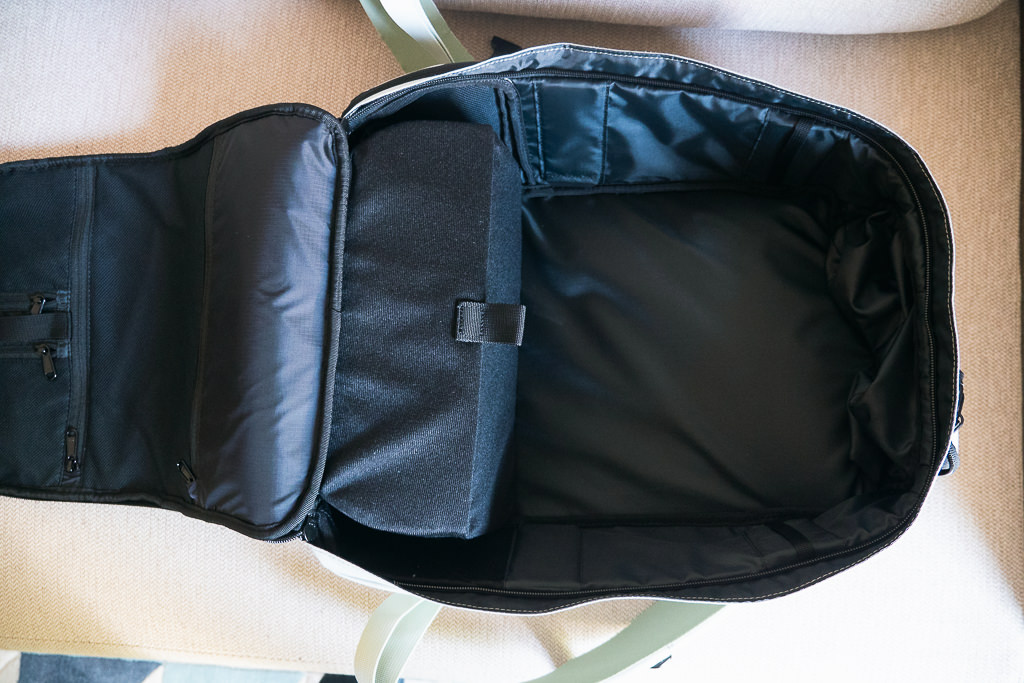
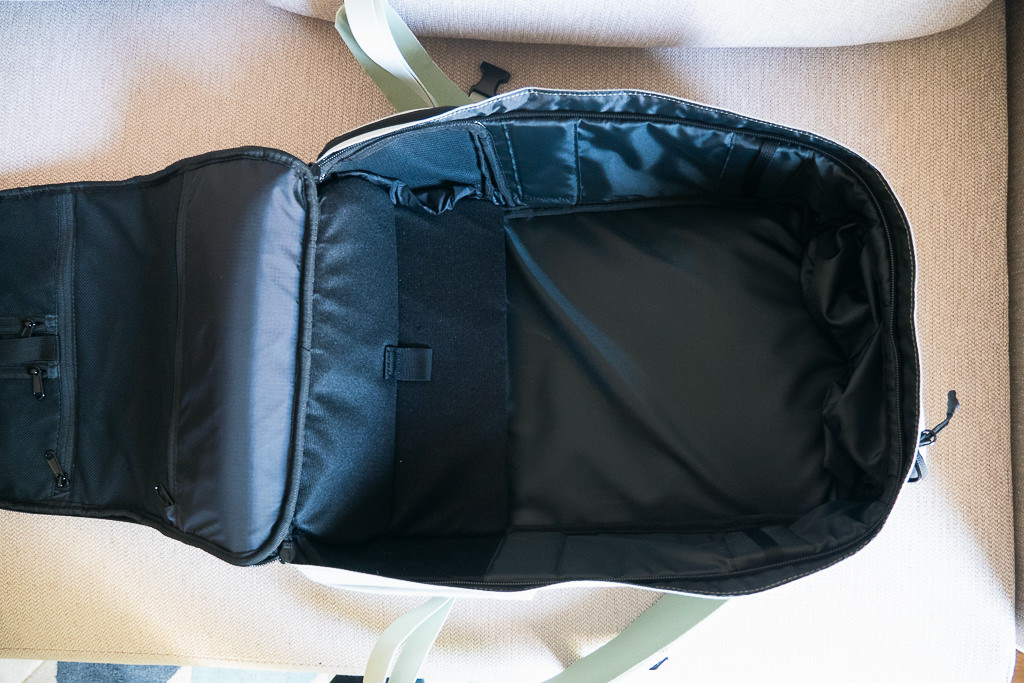
I haven’t seen this feature on other backpacks and I think it’s a piece of innovation that makes the Nest stand out from other packs.
The true size of the Nest
The Nest is advertised as being ‘up to 30 litres’ in size, though I do think this could potentially set the wrong expectations. Let me explain.
By default, the Nest is a 16-litre backpack. It can be expanded, but I do think it helps to think of it as a 16L first and foremost.
After all, it’s in this default mode that you’re most likely to use the Nest the majority of the time. It can’t really be compared directly to fully 30L capacity backpacks; consider it above all a 16L daily carry that can (in a pinch) carry a lot more than that.
The size can be increased in several ways:
1. Elastic front pocket
The front panel is made of an elastic material that will allow you to stuff something bigger in here.
The very first backpack that I bought 10 years ago (which is now out of production) actually had this feature as well and I’ve not seen it again since, so it’s cool that Tropicfeel included it on the Nest.
You can easily stuff a jumper, a raincoat, or even something bigger behind this elastic panel. It could be a great place for keeping a wet towel separate while it can still dry in the sun.
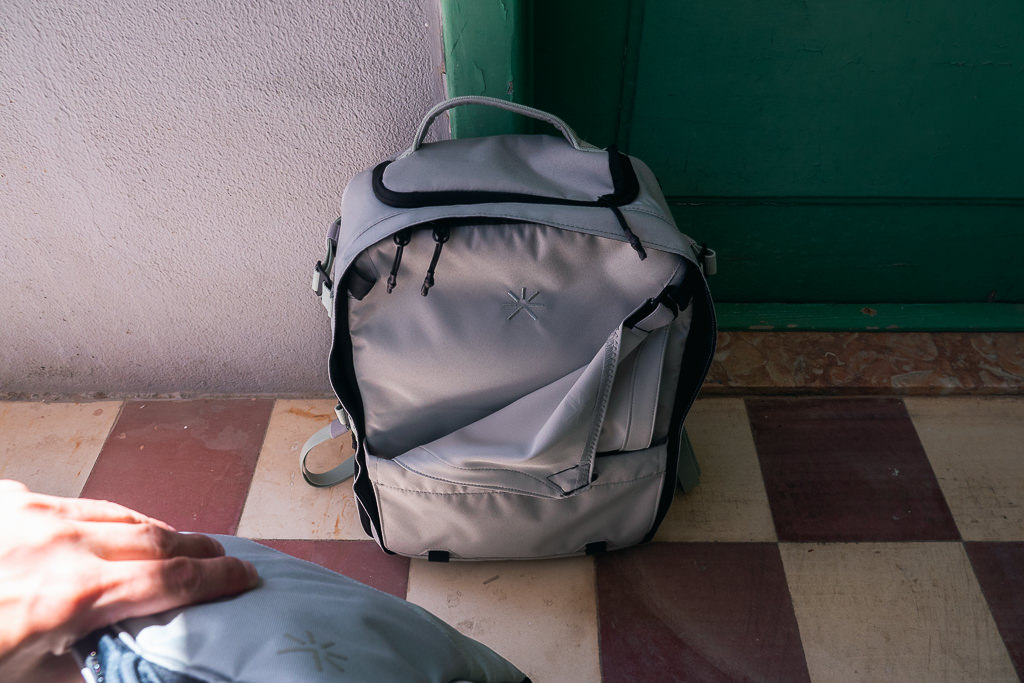
2. Smart packing cube
Tropicfeel offers several accessories that can be integrated with the Nest.
The one that I tried is the Smart Packing Cube, which feels partly like a normal packing cube and partly like an organizer.
You could pack it inside the Nest, but better yet, you can attach it to the front panel (behind the elastic material). According to the specs, this can gain you about an additional 8 liters of capacity.
The smart packing cube has a hook letting you hang it like a mini-wardrobe in your accommodation. I like this functionality without being at all bulky or heavy like the large integrated wardrobe that’s in the Tropicfeel Shell.
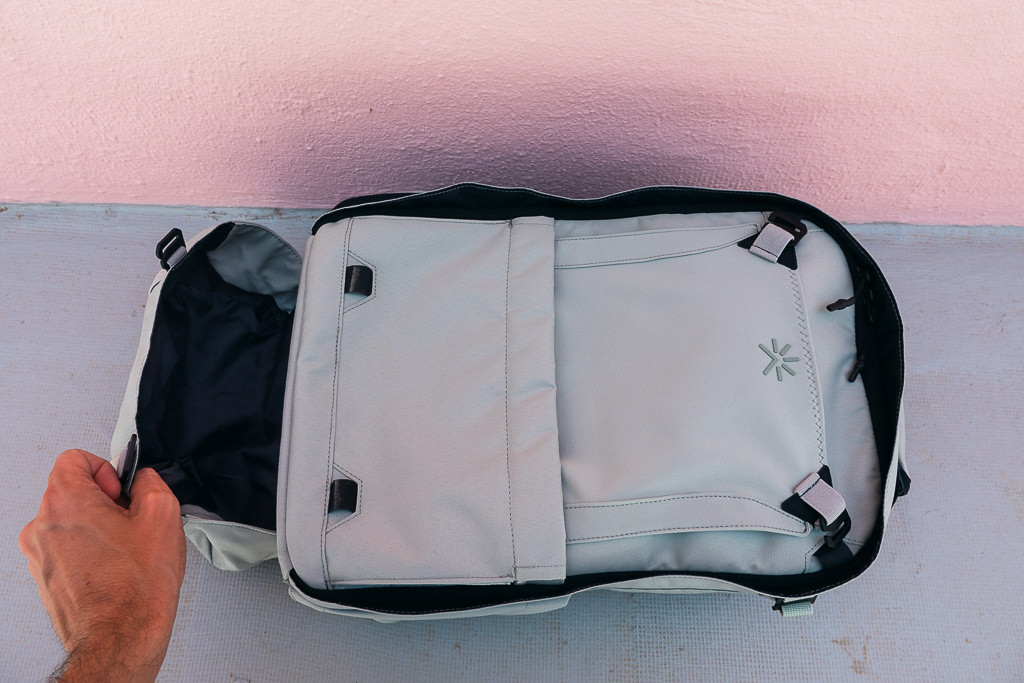
3. The kangaroo pocket
Finally, there is an unfoldable pocket that can hang a bit like a hammock at the bottom of the pack.
This is a feature shared with the Tropicfeel Shell and Tropicfeel Hive, becoming a bit of a signature feature. I liked it on the Shell and I like it here on the Nest too!
Keep in mind this kangaroo pocket is not fully shut with a zipper, so whatever is inside is slightly in the open air. I think it’s best for a pair of shoes, a jumper/hoodie or two, or perhaps a pair of jeans.
The kangaroo pocket adds about 5L of capacity.
Other features and materials
Beyond this, the Nest has many basic features that make it a versatile everyday carry. You can view an insightful product tour showing all the features.
There is a front panel with 4 inner zipped compartments, letting you easily organize your stuff.
There is a softly padded top sleeve which can be used, for example, for sunglasses or a phone.
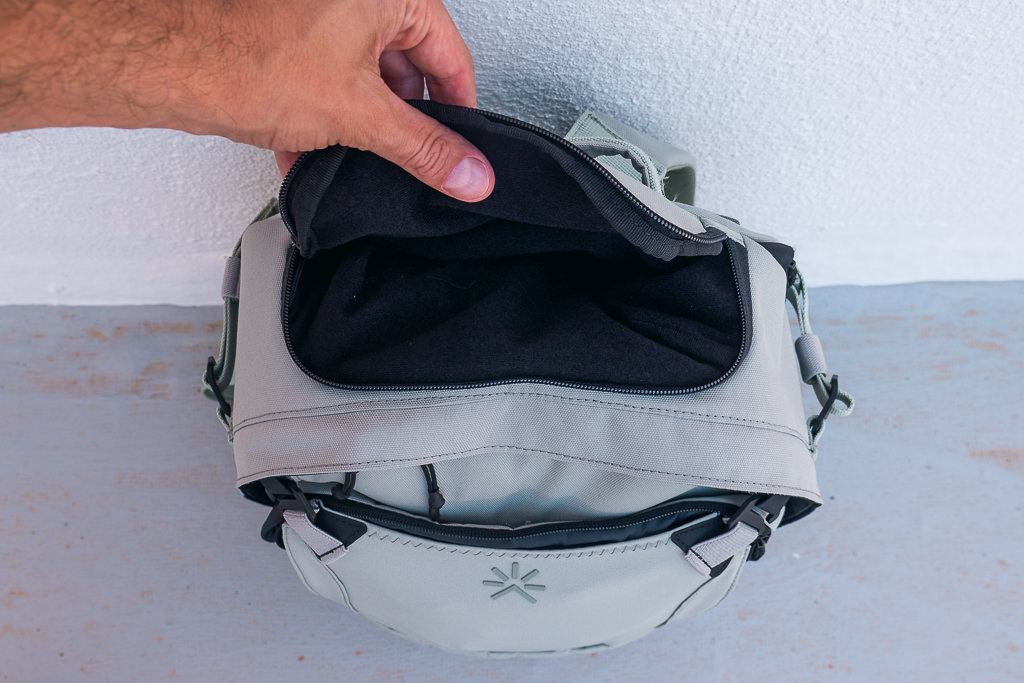
A laptop compartment can hold devices up to the size of a 15” Macbook.
On one side is a small bottle holder, which is wonderfully integrated, so that it still conforms to the overall rectangular shape of the pack when you’re not using it.
On the side is also a pair of straps that can serve as a tripod holder.
The back panel is fairly well padded. The shoulder straps are fine, and there is an adjustable sternum strap, though without a waist strap the back panel is definitely intended for light carry.
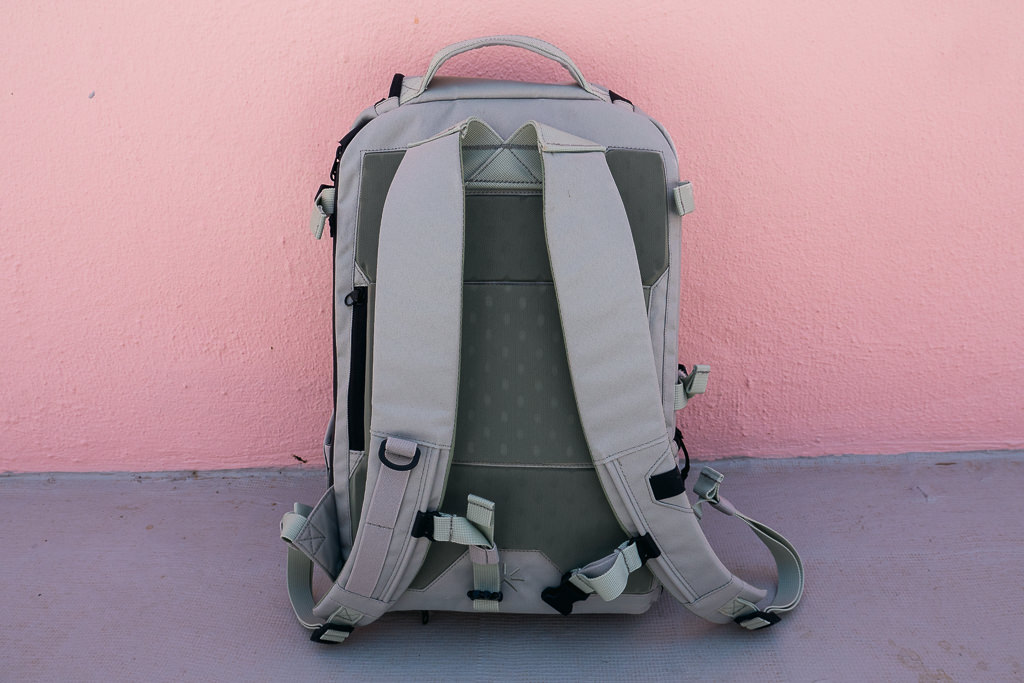
One nice touch is a little loop on one of the front straps, designed for attaching your sunglasses when you’re not wearing them.
Another nice touch is a secret compartment on the back panel intended for a passport or other travel documents.
As far as the materials go, everything is solid, though I’d also say this pack won’t knock you off your feet in terms of the materials used. For instance, while the laptop compartment has a weather-sealed rubber zipper, the others don’t. The general impression is that of a durable backpack but the materials are not particularly noteworthy.
The materials are definitely outclassed by the overall feature design, which is much more Tropicfeel’s strong point. There isn’t anything bad to say about the materials, though given the price point, there could have been some more ‘premium’ touches added here.
I do really like the overall look of this pack, which isn’t overly masculine or feminine, but can work with any style. It keeps a nice contour without looking in any way too puffy. I like the subtle mint green color of the edition that I chose.
The Nest holds its shape when not fully packed, luckily without adding any bulk or weight. The overall shape is held together by four plastic strips that are strategically positioned inside the outer shell. This is an excellent way of maintaining the overall aesthetic without needlessly weighing the pack down.
Conclusion
The Nest is a lovely bag overall. In fact, in several respects, I like it even more than the Tropicfeel Shell.
Whereas the Shell still tries to be a full-featured travel backpack using a somewhat complicated design, the Nest keeps things a bit simpler and more streamlined — I mean this in a good way.
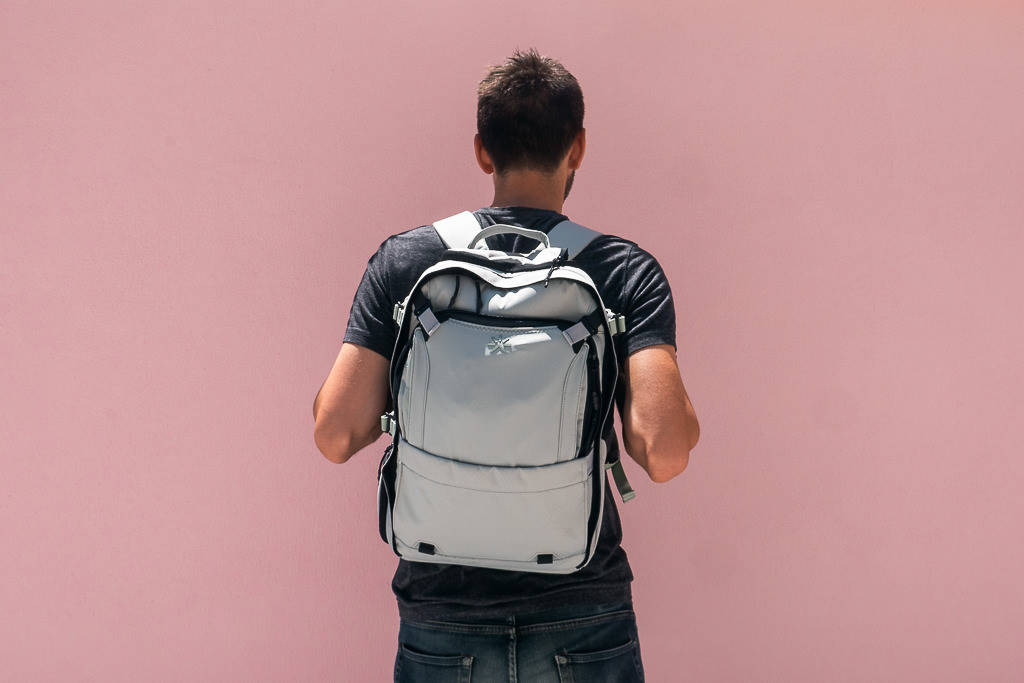
The Tropicfeel Nest knows that it’s an everyday carry first and foremost which results in a more confident overall design. Saying that, it still offers lots of versatility for you to push it a bit further, such as taking it on a weekend trip.
While technically it does go up to 30 liters, it’s still a daypack or small backpack at its core. So think of the Nest as perhaps a Mini Cooper; you can certainly expand a Mini by adding a roof rack and hooking up a small trailer, but that doesn’t mean anyone would confuse it for an SUV.
That’s essentially how I see features such as the kangaroo pouch and elastic front pocket on the Nest. They help you do much more with the pack, but they also don’t make it a substitute for a fully-sized 30L pack. As long as you know this, you will get the most out of the Nest.
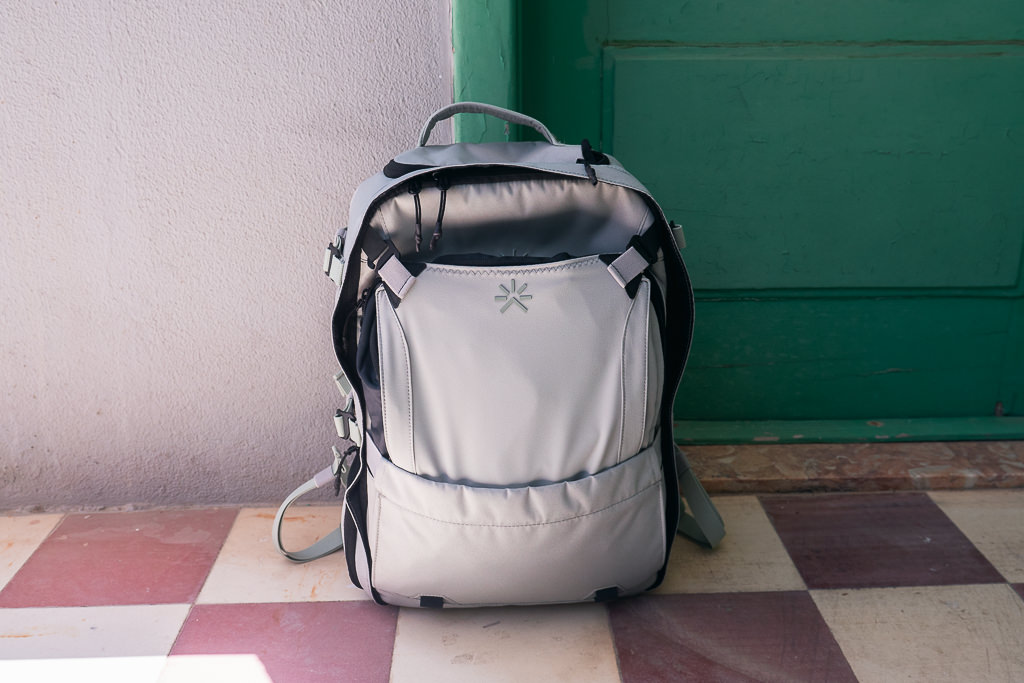
If you use the Nest as intended, then it’s an absolutely wonderful backpack. It’s small and lightweight, while offering somewhat of a Swiss Army Knife worth of packing options. It’s very easy to keep all your belongings organized inside, the back panel is comfortable for its size, and the side pocket is 100% an amazing design idea that I’ve found instantly useful as the perfect place to store my camera.
It is perhaps a bit on the pricy side, so if you are on a tight budget you may find other options out there that are priced a little lower. But if you appreciate the clever design and don’t mind the premium, then the Nest definitely gets my recommendation.
It makes for a great travel daypack (to be used in combination with a larger travel backpack) or a pack you can use in your daily life.
Some links may be affiliate links, meaning I may earn commission from products or services I recommend. For more, see site policies.
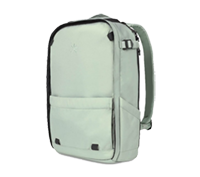
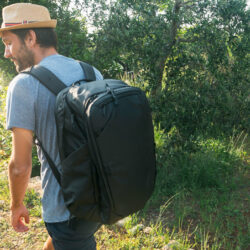
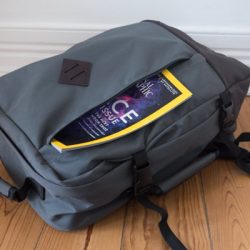



This was such a thorough no-nonsense review — very helpful in understanding the product before buying. I really appreciate it. Thanks for helping this stranger! All the best to you.
Glad it’s been helpful!